Limited success and a bunch of new mushrooming resources.
Cooler weather is upon us and that means the chanterelle mushrooms are coming into season.
Last Friday morning I went out for a hike/mushroom hunt with my hiking friend, Sue. Sue knows all kinds of things about plants and animals and even rocks, so going on a hike with her is a great learning experience. And although she doesn’t eat mushrooms, her husband does and she’s always game to go hunting with me.
The Hike
We chose a trail we both like up Icicle Creek beyond Leavenworth, WA. It’s a bit of a drive — about 50 miles from my home, including more than 10 on gravel. Another mushrooming friend of mine claimed she’d found chanterelles right on the trail. I was doubtful and I think Sue was, too. So as we hiked, we took occasional forays into the forest on one side of the trail or the other, right where we thought chanterelles might grow. I did find a very nice coral-type fungus that we believe is edible; I took it with me to examine more closely later.
Then it happened: Sue found a golden chanterelle mushroom growing right alongside the trail. While she harvested it, I combed the area looking for more. She joined me. We came up empty.
I should mention here that chanterelles are pretty easy to identify. They normally have sort of misshapen caps and the gills on the underside are more like ridges or wrinkles than regular mushroom gills. They normally extend down the mushroom’s stem. You can find photos on WikiMedia. There are some “false” chanterelles and a similar looking poisonous variety called Jack O’Lantern, but it’s pretty easy to distinguish these from real chanterelles, which are prized as tasty mushrooms. If you’re interested in hunting for chanterelles, study up first and make sure you know what you’re looking for and where you might find them.
We got to a point in the trail where we were within a quarter mile of a place I’d found chanterelles the previous year and took a little detour to check it out. I walked us over to where I found them and we searched the ground. It seemed too dry. I gave up quickly and moved off to another nearby spot, but Sue stuck with it. Soon she called out “I found one!”
I hurried back. She pointed it out and I took a photo. Then we saw one nearby that was just poking out of the forest duff.
And that’s when I started seeing little mounds all over the place. Lots of young chanterelles just popping out of the ground.
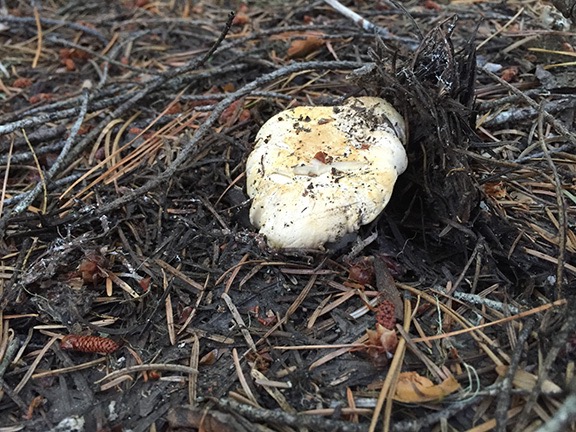
A young chanterelle mushroom, just poking out of the ground.
I used my new pocketknife — I bought one with a bright orange handle so I wouldn’t lose it while mushroom hunting — to dig a few out and put them in my bag. They were all a yellowish white color with a relatively regular looking cap. I showed one to Sue and she confirmed that they were chanterelles.
We continued to hunt in that area before getting back on the trail. Sue found some other mushrooms in various stages of decay — russulas. None of them were worth keeping, even if they were of edible varieties.
We finished our hike and headed home, stopping in Leavenworth for lunch and to buy smoked meats (Cured), wine (Ryan Patrick), and cheese (Cheesemonger).
Uncertainty
If there’s a golden rule to hunting for edible mushrooms, it’s this: never eat a mushroom you find unless you are certain that it’s edible.
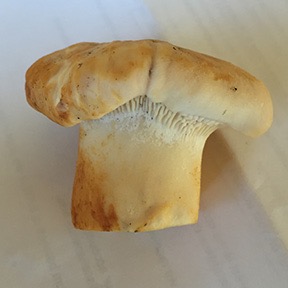
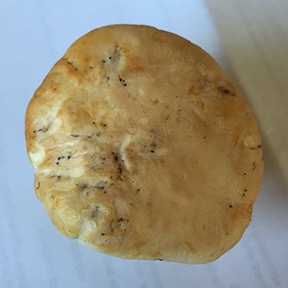
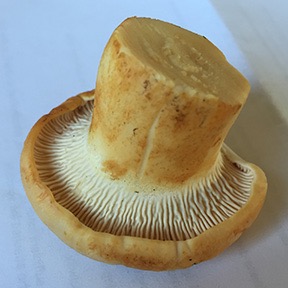
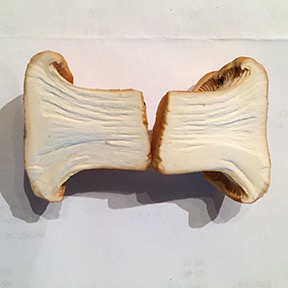
Several views of one of the mushrooms I harvested on Friday. When trying to get help with identification, it’s important to show as much detail as possible.
When I got home, I took a closer look at the five chanterelles I’d found. They were all smaller and much more “perfect” looking than any chanterelle I’d ever seen. What if Sue was wrong? What if they weren’t chanterelles and I ate them?
I combed through my mushroom books. None of the pictures matched what I had. I started to write Sue a warning email.
I posted some photos on Facebook, trying to see if any of my friends could advise me. Then I looked for and found three different mushroom identification groups on Facebook and signed up for each of them. I couldn’t post photos until I was approved for membership, though.
Then, as usual, I got sidetracked by something else and didn’t give it another thought until morning.
On Saturday morning, I was thinking about a chanterelle mushroom omelet. So I took my morning coffee to the computer and began searching the internet. I knew there was something called a false chanterelle, and I looked it up. That’s where I learned that false chanterelles have normal fin-like gills while real chanterelles have the wrinkle- or ridge-like gills. There was another chanterelle look-alike called a jack o’lantern that was definitely poisonous, but what I’d picked had very little in common with that. (Keep in mind that although I’m linking primarily to Wikipedia articles here, I consulted many sources.)
I finished the email to Sue and sent it. Then I kept researching. I wanted so badly to eat my mushrooms but I didn’t want to get sick. I’d been approved for all three mushroom identification groups on Facebook so I took and sent photos, including the ones you see here. I kept researching while I waited to hear back.
Around that time, I found a trio of photos on the Mushroom Forager website’s page about Hedgehog Mushrooms. It illustrated three similar mushrooms. The middle photo was almost identical to what I had.
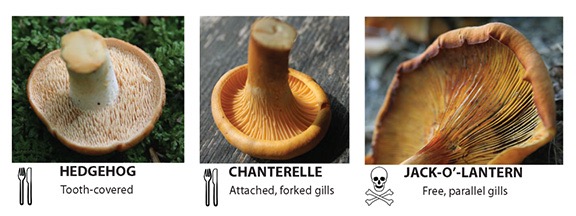
This image, which can be found at The Mushroom Forager website, helped convince me I had chanterelles.
I started cutting up my chanterelles for an omelet.
Then I checked back with Facebook. The mushroom identification group members were starting to chime in. The first few were pretty sure that it wasn’t chanterelles. I put the mushrooms away in a container in the fridge and had an omelet without mushrooms.
Throughout the day, more responses trickled in. And this is where the group dynamics really come into play. Some were sure that they weren’t chanterelles. Some were sure that they were. So I really wasn’t any better off than I’d been before consulting the groups.
Finally, late in the day, some folks who obviously knew a lot about mushrooms started responding. They identified the type of chanterelle with its genius and species: cantharellus subalbidus. While some group members argued with them, they were firm. They provided additional information about the area in which they grow: old growth forests like the one I’d been in. One even provided a link to a page that illustrated it.
I should mention here that of the three groups I joined, the Mushroom Identification Page group seemed to have the most knowledgeable participants, although none of them were free of people who offered incorrect information based on limited facts. (I really need to do a blog post about Facebook group dynamics.)
I should mention that by this time, Sue had also responded to my email. She was certain it was a cantharellus subalbidus, too. She has some resources where she looked them up. I guess she didn’t want to poison her husband!
Feasting on My Find
That evening, I sautéed some thinly sliced veal and prepared a chanterelle cream sauce for it. I had it with a side of fresh steamed green beans from my garden and glass of sauvignon blanc. Delicious.
I finished up the mushrooms the next day by cooking them into an omelet with some scallions and buckboard bacon. Very tasty.
This was my fourth mushroom hunting trip and the second for chanterelles. (I hunted twice for morels this spring.) I marked the GPS coordinates for my find and plan to return this week. Although it hasn’t rained, I’m hoping that cool, shady area of the forest is damp enough for the chanterelles to grow.
I really enjoy collecting my own food, whether it’s foraging in the forest for seasonal mushrooms, gleaning from an orchard after harvest, tending my own garden, or collecting eggs from my chickens. There’s something very special about having that kind of connection with your food.
But best of all, you can’t beat it for freshness.
Discover more from An Eclectic Mind
Subscribe to get the latest posts sent to your email.

Awesome! I haven’t seen that subspecies before. The ones by me are yellow, with thinner stems, but otherwise very similar. I have found them in Georgia, Minnesota, and now the UP of Michigan. No morels in the UP… yet. They apparently exist but I haven’t found any on my many attempts. I did however find several lbs of Black Trumpets this year while backpacking in the Porcupine Mts, We fortunately had made a wild rice soup for the overnight. We threw in as many as we could and it was magical. Sadly, since we were backpacking, we lost most of the rest to wilting before we could get back to the car.
I plan to go back tomorrow to see if there are anymore, possibly ones that were still on the ground last Friday and have grown to reasonable sizes by Thursday. The site is very close to a campground and although it’s quite a distance down Forest Road, it’s very popular on weekends. I always do my mushroom hunting on Thursdays or Friday mornings.
I’m just getting started as a mushroom hunter, so I’m concentrating on the mushrooms I know best. But I hope to be able to branch out and explore other edible varieties in my area. We don’t get much rain here, so it’ll be slim pickings. I suspect the folks on the other side of the mountains do a lot better — it’s a lot wetter out there. I’m booked with a weekend long foray for mushrooms with a local mushroom group in October; I hope to learn a lot then.
Great post, and Cantharellus subalbidus is indeed correct. The forking, gill-like ridges, rather than true gills, are important ID features to this as well as other chanterelle species. You are right about the FB mushroom groups – while some contributors are extremely knowledgeable and are true experts, others chime in without having sufficient knowledge. The most important thing for mushroom hunting is to know when you are truly positive and when you are just 99% sure. Enjoy the hunt!
Thanks for taking the time to comment. It’s the folks who chime in without really knowing that drive me nuts. Some are trying to show off, some are really trying to help. But when you first join a group, it’s so hard to know who really is knowledgeable and who isn’t.
What really cracks me up on the Facebook groups is the photos of mushrooms that show only the tops looking down from a few feet with the poster wanting to know if they’re edible — when there aren’t even enough photos to tell what they are!
You are a true scientist.
You did all the right things.
When I first saw that photo I thought, ‘Oh, that looks very pale for an emerging Chantrelle’, but the varieties you have, on a different continent, have evolved under slightly different conditions.
I speak with all the certainty of an idiot fungal forager who has made several mistakes in identification. Each bout of self-inflicted sickness adds the steep bits to the ‘learning curve”.
You are so much braver than I am. I’d never even consider eating a mushroom (or anything else I’d foraged for) without knowing for sure that it was edible.
And yes, they were very pale. I wouldn’t be surprised if they had poked out of the ground just that morning. (Mushrooms grow so fast!) But they soon got the yellowish color most people expect to see. A lot of the color, however, was likely from bruising. I really do need a real mushroom basket. I’m thinking of making one out of one of the small shipping boxes I have.
When I began foraging I went out with an expert who taught me to recognise the truly lethal Amanita phalloides (death cap). I have seen several over the years and managed to avoid them. He said that lots of fungi are edible but many safe varieties taste bland or unpleasant. He reckoned that there are about ten edible species which are tasty and worth collecting, I would say six. Most of the mushrooms you mentioned in your earlier article grow here too. My favourites are the Parasols, Chanterelles and field mushrooms. My errors have nearly always involved mistakes regarding false field mushrooms.
Bad Mushrooms have this trick of making the victim sick for a day. The victim recovers and then relapses for another two days.
Phalloides aside, there are very few types here (52N, UK) that will kill an adult. But many have serious yet non-lethal psychotropic effects.
Survivors of phalloides poisoning will often need new livers.
I actually found tow amanitas today for the first time. I took a really good look at them to make sure I understood all the characteristics. We didn’t have any luck with chanterelles today. There’s some rain in the forecast so I’m hoping that I’ll do better next week.
Yes, a warm day after heavy rain is usually productive.
30% chance of rain isn’t too promising. Despite what people think, it really doesn’t rain very much in Washington state — at least not on my side of the state.